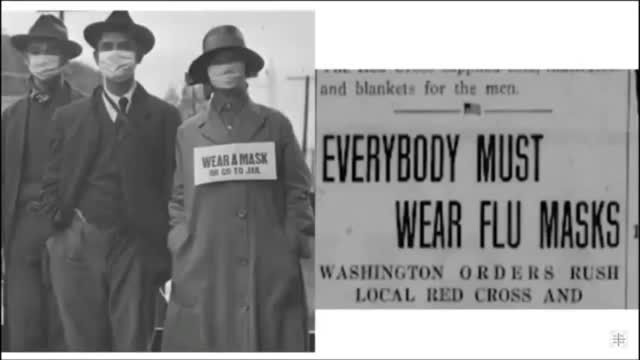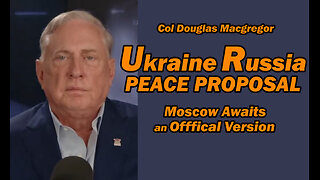Premium Only Content

'DEJA VU' COVID & SPANISH FLU VAX, SAME SCRIPT, SAME LIES, SAME GROUPS PERPETUATING IT!!!
DEJA VU' COVID & SPANISH FLU VAX, SAME SCRIPT, SAME LIES, SAME GROUPS PERPETUATING IT!!!
The Bolshevik Disease: Today’s Scamdemic is Just a Repeat of the 1918 Spanish Flu
There are far too many “coincidences” for this to be an accident. The judeo-Bolsheviks rolled out the same play book as they did 100 years ago to achieve their objectives.
Abstract
From its initial development by Carlo Forlanini at the end of the nineteenth century until the advent of antibiotics in the 1940s, artificial pneumothorax was one of the most widely used treatments for pulmonary tuberculosis. However, there were strongly held reservations about this therapy because of its risks and side effects. In the Soviet Union under Stalin, such uncertainties became instruments of political denunciation. The leading Soviet pulmonary physician Volf S. Kholtsman (1886–1941) was alleged to have used the so-called ‘aristocratic therapy’ of artificial pneumothorax to kill prominent Bolsheviks. Drawing on documents from Stalin’s personal Secretariat, this historical study of the pneumothorax scandal contributes to the cultural history of tuberculosis, showing how it was instrumentalist for political purposes.
1. Introduction: The Artificial Lung Collapse of Forlanini
In August 1882, a few months after Robert Koch published his groundbreaking discovery of the tuberculosis pathogen, the Italian doctor Carlo Forlanini (1847–1918) suggested an unorthodox method for defeating the deadly epidemic.Footnote1 Thus, the treatment method known as ‘artificial pneumothorax’ (PNX), was born. Also known as lung collapse therapy, artificial (or therapeutic) pneumothorax was unable to cure the disease completely, but it intervened in the disease process, slowing down its progression. Alongside X-ray therapy and surgical excision of tuberculosis lesions in the thorax (lobectomy), PNX was one of the most widely used treatments for pulmonary tuberculosis in the pre-antibiotic era. However, from its inception collapse therapy was highly controversial due to the frequent complications associated with its use. This professional discussion took a sinister turn in the Soviet Union under Stalin. Documents from Stalin’s personal estate reveal how uncertainties regarding the risks and side effects of artificial pneumothorax were intentionally manipulated, and illuminate how this treatment was used as an instrument of political denunciation in the 1930s.
In the mid-nineteenth century, some speculated that spontaneous pneumothorax could have a beneficial effect on the progression of tuberculosis. Such observations inspired experimentation by Forlanini, who was the first to artificially collapse the lungs for therapeutic purposes and to develop customised equipment for this purpose.Footnote2 To conduct artificial pneumothorax, filtered compressed air was pumped into the pleural space and the lungs were pressed firmly together. This allowed further progression of tuberculosis lesions to be prevented in certain circumstances.
Various hypotheses have been offered as to the causes of this favourable effect. It was believed that the temporary immobilisation of the lung and mechanical pressure permitted the draining and closure of tuberculosis cavities. Other proposed mechanisms included the reduced absorption of toxic metabolites of the pathogen and an increase in the body’s defences through the stimulation of lymphocytosis.Footnote3 To penetrate and introduce air into the pleural space, a ‘pneumo device’ was used, which consisted of a hollow needle, hydraulic pump and pressure gauge (Figure 1).
General disappointment about the failure of tuberculin as a cure for tuberculosis provided a boost to the development of Forlanini’s method at the beginning of the twentieth century.Footnote4 Although PNX was associated with a high percentage of favourable outcomes (eg. substantial improvement of symptoms could often be observed within a few days of treatment), frequent complications frustrated its general acceptance. Because extensive experience and intuition were needed to determine whether a patient was indicated for PNX, Forlanini once described it as an ‘aristocratic therapy’.Footnote5 During the 1910s and 1920s in Germany and the United Kingdom, most experts only recommended the so-called ‘gas chest treatment’ ‘as a last resort in apparently hopeless cases’ after all alternatives had been exhausted.Footnote6
When performed on elderly patients or those with large chest cavities, artificial pneumothorax was associated with a worsening of symptoms. If the lung did not release from the pleura, pleural ruptures and dangerous infections would occur.Footnote7 Pneumopleuritis was most feared, which, if it became septic, claimed patients’ lives.Footnote8 Initially, there was no clear understanding of the frequency of pleurisy (10% to 70%, according to different observers), its cause or its prognosis. Most pulmonologists attributed pneumopleuritis to endogenous factors that could not be influenced by the clinician (eg. the tuberculosis pathogen itself). Some even reported the beneficial side effects of pleural effusions. However, other sceptics cited mechanical irritation, decreasing tissue resistance and secondary infection as complications of the therapy, stoking fears of its consequences.Footnote9 As a result, use of artificial pneumothorax was widely disputed for some time.
2. The Pneumothorax Scandal
After 1917, tuberculosis (which was described by Karl Marx as ‘a living condition for capital’Footnote10) became a heated political issue in Soviet Russia. While tuberculosis had previously been glorified as a ‘self-destructive soul fire’ and a ‘romantic disease’ by writers and artists in the early nineteenth century, by the beginning of the twentieth century it morphed across Europe into a ‘disease of the proletariat’ and scourge of the victims of exploitative capitalism.Footnote11 In Imperial Russia, the literary stereotype of political dissidents suffering from consumption emerged in this context.Footnote12 With the triumph of the dictatorship of the proletariat, the motif of the tuberculosis-stricken Bolshevik martyr emerged – that hollow-cheeked hero who burned up in the fire of revolution and ‘consumption’. In actual fact, many Bolshevik leaders had suffered from tuberculosis, including the ‘Knight of the Revolution’, Felix E. Dzerzhinsky (1877–1926); the ‘Storm Petrel of the Revolution’, Maxim Gorky (1868–1936) and the ‘father of Russian Marxism’, Georgi V. Plekhanov (1856–1918). ‘The proletarian disease’ was the headline of the antituberculosis pamphlet by the first People’s Commissar of Public Health, Nikolai A. Semashko (1874–1949), which was published in 1920.Footnote13 His deputy, Zinovij P. Solov’ev (1876–1928), compared the struggle against tuberculosis with a battle against the White Army.Footnote14 These heroic connotations found artistic expression 1926, when the classic film The Mother featured the actor Nikolay P. Batalov (1899–1937), who had suffered from severe tuberculosis, in the starring role of the revolutionary leader Pavel.Footnote15
But naturally, the struggle against tuberculosis was much more than metaphorical. Tuberculosis was a common cause of death among adults during the 1920s.Footnote16 It is hardly surprising, then, that the disease stood at the centre of the Soviet Union’s early public health programme, embedded in the bio-political project to create the New Soviet Man.Footnote17 From the very beginning, victory over tuberculosis was an inherent part of the promise of Communism. However, as the political situation grew more tense following the abandonment of the New Economic Policy (NEP) in 1929–30, calls grew loud to eliminate the disease within two Five Year Plans. In this context, the Communist leadership strove to end the egalitarian health care policies of the 1920s and provide privileged treatment to the proletariat – and not just in the effort to battle tuberculosis.Footnote18
Correspondingly great were the political expectations placed upon Professor Volf S. Kholtsman [Holzman] (1886–1941), who during period of political change (Stalin’s ‘Great Break’ 1929–30) became the director of the Moscow Oblast Tuberculosis Institute (MOTI). Kholtsman was a central figure among Soviet ‘phthisiatrists’ during the 1930s. Kholtsman had studied medicine at Moscow University, where he graduated in 1911. He began his medical work as a doctor of the Moscow University Clinic before moving to tuberculosis sanatorium ‘Vysokie gory’ in 1916, where he remained as a Deputy Chief Physician until 1928. The first purge at the Moscow Department of Public Health in 1928–9 was a considerable boon to Kholtsman’s career. By 1935 he was the head of both of Moscow’s large tuberculosis institutes: the MOTI and CTI (Central Tuberculosis Institute). Yet he was unable to maintain this position of ascendancy for very long – the Soviet secret police arrested him in 1939 (Figure 2).Footnote19
For decades the fate of this leading Soviet lung doctor remained unknown.Footnote20 Only with the opening and researching of Soviet archives have new sources shed light onto his death. Such sources include Stalin’s so-called ‘shooting lists’ which, after decades of strict secrecy, were published by the human rights organisation ‘Memorial’. Most recently, the Archive of the President of the Russian Federation published the ‘shooting lists’ in an updated and expanded version on the sixtieth anniversary of Stalin’s death in March 2013. Kholtsman’s name is among the several thousand individuals identified for execution in these lists, which were usually signed by Stalin personally. As revealed by other contemporary sources, including documents from the Russian State Archive of Social–Political History (RGASPI), artificial pneumothorax played a role in his tragic fate.
The response to PNX at the beginning of the 1920s in Soviet Russia was more open-minded than, for example, in Germany.Footnote21 In Russia the method was applied for the first time as early as 1910 by Arkadij N. Rubel (1867–1937).Footnote22 In 1912 he wrote the very first monograph on this issue and contributed significantly to its popularisation after the October Revolution.Footnote23 Kholtsman was among those lung doctors who campaigned for the widespread introduction of PNX, including double-sided lung collapse, for the treatment of tuberculosis as a standard method, and considered the complication rates acceptable.Footnote24 But precisely on this controversially discussed issue of side effects and risks, he made himself vulnerable after Stalin had proclaimed his ‘theory on the aggravation of the class struggle’ in 1929. In the same year, a young doctor named Ilja A. Slobodjanik appeared at Kholtsman’s door with a transfer order from the Moscow health authority, introducing himself as Kholtsman’s new colleague. Slobodjanik claimed to have connections. In fact, he had been able to make contacts with important party functionaries through his previous work at the Karl Liebknecht tuberculosis sanatorium near Moscow, a luxury sanatorium for Bolshevik luminaries.Footnote25 Slobodjanik seemed to perfectly embody the contemporary goals of Bolshevik social and educational policy. His rise was perhaps also abetted by the broader effort underway to identify ‘natural talents’ among working-class and farming families. Such ‘talents’, labelled vydvizhentsy (‘promotees’), were to offer a counterpoint to old specialists (specy), bringing fresh ideas and innovation.Footnote26 One of the most prominent individuals to profit from this policy of encouraging young talent was Trofim D. Lysenko (1898–1976), a representative of Michurin agrobiology who was celebrated by the Soviet press as a ‘barefoot professor’. Lysenko demonised genetics as ‘bourgeois pseudoscience’ and his rise led to a multi-decade moratorium on Soviet genetic research.Footnote27 Looking on Slobodjanik’s career it might be assumed that an attempt was made, as so often in the Soviet Union, to manufacture a hero in the public eye – only in this instance in the field of physiology.
Even early in his career as a sanatorium physician Slobodjanik was a lively inventor, initially focusing on household and medical appliances (eg. a furnace for the burning of infectious sputum).Footnote28 He touted supposed ‘miracle’ cures for tuberculosis, made from specially developed adonis and yarrow extracts, but was convicted of fraud and plagiarism. Although he was exposed as a plagiarist, as a hopeful vydvizhenets and unorthodox inventor he was defended by the Rabkrin (Workers’ and Peasants’ Inspectorate) and got a second chance.Footnote29 Yet once at the Tuberculosis Institute, Slobodjanik quickly became an epicentre of controversy when he claimed to have revolutionised the apparatus for administering PNX by equipping it with special oil filters.Footnote30
Ironically, this technical improvement was soon overlaid with ideological connotations. From 1930 onwards a mass public health campaign for ‘cleanliness’, labelled sanminimum (minimum sanitation), had been underway all over Soviet Russia.Footnote31 In what would appear to be a blatant effort to benefit from the much celebrated ‘storm for sanminimum’ during the First Five-Year Plan, in March 1932 Slobodjanik reported on the supposed ignorance and neglect of basic sanitary standards at the Tuberculosis Institute in the newspaper Izvestija, the official Organ of the Presidium of the Supreme Soviet, in an article titled ‘Into the fight against the routine in tuberculosis therapy’.Footnote32 Although Kholtsman considered pneumopleuritis to be an endogenous and unavoidable complication in PNX,Footnote33 Slobodjanik accused him of not wanting to do anything about this problem. Pneumopleuritis occurred in far more than 50% of PNX treatments, Slobodjanik claimed, of which almost half ended in septic form, which had a 50% mortality rate. The article asserted that Kholtsman concealed this risk and watched quietly as honoured Old Bolsheviks died from complications.Footnote34
Pneumopleuritis arose from the compression therapy itself, Slobodjanik argued, asserting that while the lung tissue is destroyed by a severe increase in intrapleural pressure, the pneumo apparatus acts like a bacterial dispenser, pressing airborne germs into the fresh wounds inside. Slobodjanik claimed to have analysed airborne germs in the treatment rooms of the Institute of Tuberculosis and to have found countless staphylococci and moulds. Slobodjanik claimed that by ignoring these evident facts and denying the cause of iatrogenic infection, experts in the field did not uphold the most elementary standards of asepsis. Slobodjanik maintained that his newly developed hygienic device (Figure 3), with its special bactericidal oil filter of camphor, menthol, and thymol, could kill germs and lower the pleuritis rate to just 2%.Footnote35 Riding on the wave of the ideological campaign for ‘cleanliness’, Slobodjanik apparently wanted to draw on the old conflict between the advocates and opponents of antisepsis and asepsis while stylising himself as a Russian Semmelweis – the famous ‘saviour of mothers’ from Vienna who branded all gynaecological experts as ‘murderers’ because they disputed the contagious origin of childbed fever. The fact that this association was still possible and plausible eighty years later, during the 1930s may seem surprising. To explain this, it must be mentioned that collapse therapy, which originally fell into the sphere of competence of surgeons, became the domain of ‘phthisiatrists’ in the 1920s. But this sort of physician, Slobodjanik argued, in contrast to surgeons, did not take the principles of asepsis seriously.Footnote36
What began as a technical debate with political accusations in 1932 led to the veritable political destruction of the renowned Institute Director by 1935. Alexander S. Serafimovich (1863–1949), a ‘classic’ writer of socialist realism during his lifetime, added new momentum to the debate. The subject of tuberculosis was a personal one for Serafimovich. After he was implicated, along with Lenin’s brother Alexander, in an assassination attempt against the Tsar in 1887, he was sent into exile and became ill with tuberculosis. In his article ‘A crime of the physician’ published in the newspaper Pravda, Serafimovich attacked Professor Kholtsman as a former Menshevik party member who systematically covered up fatal medical errors.Footnote37
The timing was catastrophic: in the summer of 1935, the three-act drama Platon Krechet written by famous Soviet dramatist Alexander E. Korneychuk (1905–72) hit the stages of the Soviet Union. The piece was about the struggle of a talented young surgeon named Krechet against bureaucracy and hypocrisy in medicine, embodied by the clinic Director Arkadij, who hid his true face behind politically convenient rhetoric about the ‘dialectical method of tuberculosis healing’. Meanwhile, he sent innumerable patients home, deeming them incurable, instead of fighting to the very last for their health.Footnote38 On 13 June 1935, after a successful performance of the play at the Gorky Moscow Art Theatre (MChAt), a review of the play in Pravda tersely said: ‘These people must be unmasked and relentlessly beaten’.Footnote39 In the same issue, Pravda reported extensively on the alleged crimes of Kholtsman.Footnote40
A document from Stalin’s private estate held at the Russian State Archive of Socio-Political History (RGASPI) shows that the campaign against Kholtsman was approved by the highest authority. Serafimovich addressed a personal letter to Stalin on 16 May 1935, before he sent his denunciatory article to the newspaper.Footnote41 In it, he vilified in drastic words the clique of ‘Kholtsmanists’, whose tentacles even reached to the ‘opportunist’ Nikolai I. Bukharin (1888–1938).Footnote42 Honourable comrades, he stated, were continuously mistreated at the Institute of Tuberculosis or sent home to die. They all would have died, Serafimovich asserted, without Slobodjanik’s intervention at the last minute:
This is terrible, Comrade Stalin. Because it is not about individual cases – there is a system behind it. This is an organisation against which all are powerless. This is a fighting organisation of old doctors that has infiltrated all institutions, police stations, associations, newspaper offices, educational institutions, and private homes – anywhere they have their own agents …Of course, medical errors are inevitable, but once they become part of the system, it is suspicious …Kholtsman hated Slobodjanik, he hated him because Slobodjanik (against his orders) healed patients. …I strongly urge your permission to go to the press.Footnote43
Serafimovich’s request was obviously granted, although his Pravda article used less acerbic language than his letter.Footnote44 In summer 1935 there was supposedly political interest in continuing this public debate. Kholtsman was granted a chance to respond to Serafimovich’s attacks in the same newspaper. The ‘phthisiatrist’ published a comprehensive rebuttal, half of which discussed the aetiology and pathogenesis of pneumopleuritis. Overloaded with specialist terminology, the article was incomprehensible to lay readers. Kholtsman denied the high PNX complication rates cited by SlobodjanikFootnote45 and claimed that his opponents would be responsible for the negative consequences to public health resulting from this professional debate being carried out in newspapers. Indeed, tens of thousands of frightened tuberculosis patients lost confidence in the medicine and PNX, and thus avoided receiving beneficial treatment.Footnote46
Yet Kholtsman underestimated the extent to which a general mistrust of medicine had become prevalent. Serafimovič had stated that Slobodjanik’s main contribution lay in ‘shaking the confidence placed in doctors’. He didn’t just portray him as a selfless fighter for the sanminimum, but also as someone who encouraged patients to mistrust doctors and to demand that they wash their hands. In this way, he was advocate of a radical reversal in the traditional doctor–patient relationship.Footnote47 Accordingly, the main target of the writer was ‘the horrible principle of “medical confidentiality”, of the “medical ethics” that previously prevailed among bourgeois doctors and still holds sway abroad today, a “medical ethics” that turns the doctor into a sorcerer’.Footnote48
The deeper meaning of this rhetoric first becomes clear within the context of the tensions that prevailed in the field of medicine in the early Soviet Union. After the October revolution, the doctor, like the priest, was often portrayed as a representative of the bourgeois milieu or, alternatively, as an agent of the czar’s political apparatus of oppression. Accordingly, a logical extension of the overthrow of the state was to usher in a revolution in the field of medicine. In the mid-1920s there were mass protests against the medical profession, and doctors were even assaulted and murdered.Footnote49 Collective resentment against ‘medical augurs’ led to the demand, that ‘Soviet doctors perform their work transparently under the glass bell jar of the worker and farmer movement’.Footnote50 After the ‘great upheaval’, uncontrolled violence ‘from below’ against medical professionals declined sharply. Yet ‘from above’ the field of medicine was declared a sphere of activity in which the threat of sabotage was particularly high.Footnote51 During the Stalinist purges of the 1930s and again in 1952–3, the doctor was portrayed as a perfidious ‘mixer of poisons’ who sought to murder the New Soviet Man.Footnote52
In 1935–6 there was a pause in the Stalinist terror. Kholtsman was left temporarily in his position as Director of the CTI. Yet after 1936, the campaign to generate resentment towards doctors continued. Allegations peaked during the show trial against the so-called ‘Bloc of Rightists and Trotskyites’ in March 1938, as several Kremlin physicians were accused of having insidiously eliminated reliable party members. Lev G. Levin (1870–1938), head physician of a Sanitary-Clinical Department of the Kremlin – responsible for health care for political elites – had supposedly ‘collaborated’ with the renowned professor Dmitri D. Pletnev (1871–1941) at the behest of the ‘traitor’ Genrikh G. Yagoda (1891–1938) in order to assassinate old Bolsheviks. Difficult heart or lung conditions that led to the death of the patient were thus ‘exposed’ as incidents of ‘slow murder’, as treatment methods known to be improper had ostensibly been used. At the show trail, the public learned a number of disturbing facts: not sickness, but mistreatment at the hands of perfidious ‘mixers of poison in white smocks’ had led to the untimely death of a number of prominent figures, including OGPU head Vyacheslav R. Menzhinsky (10 May 1934), the chairman of the Government Supervisory Commission Valerian V. Kuybyshev (25 January 1935), and the great proletariat writer Maxim Gorky (18 June 1936).Footnote53 Entire newspaper pages were devoted to the publication of collective letters of protest and resolutions, all of which made similar calls, including ‘No pardon for murderous doctors’, ‘Fascist dogs up against the wall’, and ‘Die you beasts!’Footnote54 In his poem ‘Death to the Traitors’, the rising propaganda poet Sergey A. Vasiljev (1911–75) showcases a flair of demagogy in describing his impressions of the courtroom:
At that time, as Gorky’s bright gaze
Turned to the people, to the starlight,
He closed the garden window tightly,
And gave him the deadly potion.
Where is your human side?
At this thought, one shivers:
The earth curses you – but you
continue to walk its face, you still live!Footnote55
In his indictment, which called for special vigilance in dealing with physicians, chief prosecutor Andrey J. Vyshinsky (1883–1954) warned that:
Criminal history and a chronicle of murder offences show that poisoning by professional assassins has rarely occurred in the last decades. Doctors have taken the place of such poisoners.Footnote56
A feverish search for other, as yet undiscovered ‘murderers in white coats’ began, until finally it was Professor Kholtsman’s turn. On 4 June 1939, he was arrested as a spy, accused for providing secret data about the health care of the Red Army to the German intelligence service. On 30 July 1941, he was executed. A direct connection to the case against the ‘Right-Trotskyist bloc’ was constructed in a memorandum that has survived along with the shooting list of 6 September 1940. According to it, Kholtsman allegedly murdered prominent pulmonary patients on behalf of the Kremlin doctor, Lev G. Levin, who had already been executed.Footnote57 Stalin’s private secretary Ivan P. Tovstucha (1889–1935) was one of Kholtsman’s alleged victims. In a historical irony, Tovstucha was one of Stalin’s most faithful paladins, and was entrusted with compiling Stalin’s shooting lists.Footnote58
3. Conclusion
In summary, ‘the doctor’ was often portrayed as an untrustworthy and lurid figure in Russian cultural history.Footnote59 A fortiori, Stalinism labelled doctors as a class enemy. A well-known incident in this connection is the Doctors’ Plot of 1952–3, an anti-Semitic campaign against ‘rootless cosmopolitans’ that led to the arrest of many doctors. However, this campaign, also referred to ‘Stalin’s last crime’,Footnote60 had a no less dramatic prelude during the 1930s. In the history of Soviet pulmonary medicine offered here, we find that hostile sentiments toward the medical profession took a particularly virulent form in the 1930s under Stalin. The international debate about the risks and side effects of the ‘aristocratic therapy’ offered a fertile breeding ground for abstruse speculations and suspicions, as witnessed in the writings of Slobodjanik and Serafimovič. Under these conditions, the history of medicine took an unprecedented turn: The ‘terapia aristocratica’ was portrayed as an insidious means of the class enemy to eliminate diseased old Bolsheviks suffering from the ‘proletarian disease’. In this way, the controversial pneumo device was stylised as a ‘killing machine’.
Finally, I would argue that this historical episode highlights an important gap in the literature. While research on the political history of medicine has enjoyed a tremendous flowering in recent years, and impressive insights have been generated, compared with the volume of research conducted on National Socialism medicine in the Soviet context has garnered relatively scant attention. Clearly, the episode discussed in this paper is part of a much larger complex of events that merits greater critical examination, as there are a myriad unresolved questions and unexamined sources just waiting for investigation by medical historians.
This research appears to have systematic importance for the historiography of medicine in the twentieth century. The Soviet model of health care was and is a highly polarising projection screen for positive and negative stereotypes alike. But what lies behind these attributions remains for the most part terra incognita, with much careful reconstruction still needed. Archival sources are rich, but carry with them a certain risk of empiricism. In filling in the many blanks, scholars of Soviet medical history must also test and evaluate new conceptual tools. These tools should not be limited to Foucauldian techniques such as biopower, whose use has become inflationary. During the post-communist period, numerous re-interpretations of the Soviet system and Stalinism appeared, including those of Stephen HansonFootnote61, Zygmunt Bauman,Footnote62 Stephen Kotkin,Footnote63 Johann Arnason,Footnote64 Sheila FitzpatrickFootnote65 and Stefan Plaggenborg.Footnote66 Combining these approaches with historiographical terms such as professionalisation or medicalisation promises to yield rich discoveries, which could form the basis for future comparative studies and the contextual re-thinking of Soviet medical history – and underpin the particular histories of Europe’s medical cultures.
References
1
Forlanini, Carlo, ‘A contribuzione della terapia chirurgica nella tisi del polmone: Ablazione del polmone? Pneumotorace artificiale?’, Gazzetta degli Ospedale e della Cliniche di Milano, 3 (1882), 537.Google Scholar
2
Sakula, Alex, ‘Carlo Forlanini, Inventor of Artificial Pneumothorax for Treatment of Pulmonary Tuberculosis’, Thorax, 38 (1983), 326–332.CrossRefGoogle ScholarPubMed
3
Clive Riviere, The Pneumothorax Treatment of Pulmonary Tuberculosis (London: Oxford University Press, 1917), 6–12; M. Gutstein, ‘Der künstliche Pneumothorax: Uebersichtsreferat’, Berliner Klinische Wochenschrift, 48 (1918), 1152–5.Google Scholar
4
Sakula, ‘Carlo Forlanini’ (note 2), 328.Google Scholar
5
Carlo Forlanini, ‘Il pneumotorace artificiale nella cura della tisi pulmonare’, in Atti de VII Congresso Internazionale Contra la Tuberculosi, Vol. 3 (Rome, 1912), 182.Google Scholar
6
Parry Morgan, ‘Artificial Pneumothorax in the Treatment of Pulmonary Tuberculosis’, Quarterly Journal of Medicine October 1917, 1–17, 1; Alfons Winkler, ‘Über plastische Pleuritis bei künstlichem Pneumothorax’, Beiträge zur Klinik der Tuberkulose und spezifischen Tuberkulose-Forschung, 54, 4 (1923), 335–43.Google Scholar
7
T.G. Heaton, ‘Complications of Artificial Pneumothorax’, Canadian Medical Association Journal, 35, 4 (1936), 399–405; R.C. Hutchinson and L.G. Blair, ‘Lung Rupture in the Artificial Pneumothorax Treatment of Pulmonary Tuberculosis’, Tubercle, 7, 9 (1926), 417–24; Adolf Sylla, Lungenkrankheiten einschließlich der Erkrankungen der oberen Luftwege und des Brustfells (Munich: Urban & Schwarzenberg, 1952), 574–6.Google Scholar
8
Riviere, op. cit. (note 3), 120 ff.; H. Alexander, Der künstliche Pneumothorax (Berlin: Springer, 1931).Google Scholar
9
Alexander, op. cit. (note 8); Ludwig von Muralt, Der künstliche Pneumothorax (Berlin: Springer, 1922).Google Scholar
10
Karl Marx, Das Kapital, in: Karl Marx and Friedrich Engels, Werke, Vol. 23 (Berlin: Dietz, 1968), 506.Google Scholar
11
H.D. Chalke, ‘The Impact of Tuberculosis on History, Literature and Art’, Medical History, 6, 4 (1962), 301–18; Sylvelyn Hähner-Rombach, Sozialgeschichte der Tuberkulose. Vom Kaiserreich bis zum Ende des Zweiten Weltkriegs unter besonderer Berücksichtigung Württembergs (Stuttgart: Steiner, 2000), 32–40.Google Scholar
12
Konstantin A. Bogdanov, Vrači, pacienty, čitateli: Patografičeskie teksty russkoj kul’tury XVIII–XIX vekov (Moscow: OGI, 2005), 300.Google Scholar
13
N.A. Semaško, Proletarskaja bolen’ (tuberkulez) (Moscow: Izdatel’stvo Narkomzdrava, 1920).Google Scholar
14
Zinovij P. Solov’ev, ‘Čerez diktaturu proletariata – k pobede nad tuberkulezom’ (1924), in: Zinovij P. Solov’ev (ed.), Voprosy social’noj gigieny i zdravoochranenija: Izbrannye prozvedenija (Moscow: Medicina, 1970), 61.Google Scholar
15
S.S. Mokul’skij (ed.), Teatral’naja ėnciklopedija, Vol. 1 (Moscow: Sovetskaja ėnciklopedija, 1962), 547.Google Scholar
16
See, eg., Data for Tuberculosis Mortality in Moscow per 10 000 Population: 1914 (25), 1917 (20), 1920 (40), 1927 (16), 1931 (14.7), 1933 (16.1), 1934 (16.5), 1935 (13.8). Michael Zdenek David, ‘The White Plague in the Red Capital: The Control of Tuberculosis in Russia, 1900–1941’, (unpublished PhD diss.: University of Chicago 2007), 136, 287, 423.Google Scholar
17
David, op. cit. (note 16), 51, 135, 138.Google Scholar
18
Ibid., 287, 291.Google Scholar
19
Chol’cman, Volf Semenovič, ‘K 25-letiju naučnoj, vračebnoj i obščestvennoj dejatel’nosti’, Problemy tuberkuleza, 12 (1936), 1625; A.A. Klebanova: ‘K 100-letiju so dnja roždenija V.S. Chol’cmana’, Problemy tuberkuleza, 12 (1987), 68–70.Google Scholar
20
David, op. cit. (note 16), 542.Google Scholar
21
See statements of leading Soviet pulmonary doctors: A. Šternberg, Iskusstvennyj pnevmotoraks pri tuberkuleze legkich (Leningrad, 1929); A. Furman, Iskusstvennyj pnevmotoraks v klinike legočnogo tuberkuleza (Moscow and Leningrad, 1929); V. Chol’cmann (Red.), Materialy po kollapsoterapii legočnogo tuberkuleza (Moscow, 1931); V. Chol’cman and V. Čukanov, ‘Pnevmotoraks’, Bol’šaja medicinskaja ėnciklopedija, Vol. 25 (Moscow: Sovetskaja ėnciklopedija, 1933), 694–720, 702.Google Scholar
22
A.N. Rubel’, Bol’šaja sovetskaja ėnciklopedija, Vol. 37 (Moscow: Sovetskaja ėnciklopedija, 1955), 277.Google Scholar
23
A.N. Rubel’, Iskusstvennyj pnevmotoraks pri lečenii tuberkuleza legkich: Technika operacii (St Petersburg: Praktičeskaja medicina, 1912).Google Scholar
24
Chol’cman and Čukanov, op. cit. (note 22), 702.Google Scholar
25
Moskovskie sanatorii: Sbornik statej i materialov (Moscow: Moszdravotdel, 1925), 157.Google Scholar
26
Sheila Fitzpatrick, Education and Social Mobility in the Soviet Union 1921–1934 (Cambridge: Cambridge University Press, 2002), 235–49.Google Scholar
27
David Joravsky, The Lysenko Affair (Cambridge, MA: Harvard University Press, 1970).Google Scholar
28
Slobodjanik, I.A. Patents, in: Database Patent Office USSR, http://patentdb.su/patents/slobodyanik/page/(accessed 12 May 2013).Google Scholar
29
This was alleged in an open letter that was signed by 17 members of the Tuberculosis Institute: ‘Otkrytoe pis’mo tov. Serafimoviču’, Pravda 07.06.1935, Nr. 155, 2.Google Scholar
30
Il’ja A. Slobodjanik, ‘O zagrjaznjaemosti vozducha v apparatach dlja pnejmotoraksa’, Vračebnoe delo, 1–2 (1931), 70–2.Google Scholar
31
A. Sysin, ‘Sanitarnyj minimum’, Bol’šaja medicinskaja ėnciklopedija, Vol. 29 (Moscow: Sovetskaja ėnciklopedija, 1934), 665–771.Google Scholar
32
Il’ja A. Slobodjanik, ‘Na bor’bu s rutinoj v lečenii tuberkuleza’, Izvestija, 27.03.1932, No. 85, 3.Google Scholar
33
Vol’f S. Chol’cman, ‘V čem že prestuplenija vrača?’ Pravda, 05.06.1935, Nr. 153, 3.Google Scholar
34
Slobodjanik, op. cit. (note 33), 3.Google Scholar
35
Slobodjanik, op. cit. (note 31), 70–2.Google Scholar
36
Slobodjanik, op. cit. (note 33), 3.Google Scholar
37
Aleksandr V. Serafimovič, ‘Prestuplenie vrača’, Pravda, 01.06.1935, No. 149, 2.Google Scholar
38
Aleksandr E. Kornejčuk, Platon Krečet, in Aleksandr E. Kornejčuk, Sobranie sočinenij v četyrech tomach, Vol. 1 (Leningrad: Lenizdat, 1976), 101–58.Google Scholar
39
B. Reznikov, ‘Platon Krečet’, Pravda, 15.06.1935, No. 163, 4.Google Scholar
40
‘Medicinskaja obščestvennost‘ o prestuplenija vrača’ Pravda, 15.06.1935, No. 163, 3.Google Scholar
41
Aleksandr V. Serafimovič to Iosif V. Stalin, Letter, 16 May 1935. Source: Russian State Archive of Social-Political History (RGASPI), f. 558, op. 11, d. 806, l. 104–11.Google Scholar
42
Bukharin, formerly a powerful member of the Politburo, fell from grace in 1929 as a right-opportunistic deviator and had in 1935 the rather modest position as editor in chief of Izvestija. Stephen F. Cohen, Bukharin and the Bolshevik Revolution: A Political Biography, 1888–1938 (Oxford: Oxford University Press, 1980),270–337.Google Scholar
43
Serafimovič to Stalin, Letter, op. cit. (note 42).Google Scholar
44
Serafimovič, op. cit. (note 38), 2.Google Scholar
45
Kholtsman estimated the rate of the septic pneumopleuritis 7–8 times lower than Slobodjanik. Chol’cman, op. cit. (note 34), 3; Chol’cman, Čukanov, op. cit. (note 22), 716.Google Scholar
46
Chol’cman, op. cit. (note 34), 3.Google Scholar
47
Serafimovič, op. cit. (note 38), 2.Google Scholar
48
Ibid.Google Scholar
49
G.A. Berdičevskij, ‘Bol’noj vopros vračebnoj raboty’, in Trud i byt sovetskogo vrača (Kharkov: Acta medica 1928), 33–43.Google Scholar
50
S.A. Gurevič, ‘Ėvoljucija ličnosti vrača’, Moskovskij medicinskij žurnal, 10 (1928), 5–16, 13.Google Scholar
51
N. Vachmutskij, ‘Problema kadrov v dele zdravoochranenija’, in Izvestija, 20.03.1930, No. 78, 2.Google Scholar
52
Mark B. Mirskij, ‘Processy ‘vračej-ubijc’: 1929–1953 gody’, Voprosy istorii, 4 (2005), 73–93.Google Scholar
53
Ibid.Google Scholar
54
See, for example Headlines in Pravda, 11.03.1938, No. 69, 1–5.Google Scholar
55
Sergej Vasil’ev, ‘Smert‘ predateljam!’ Pravda, 11.03.1938, No. 69, 1.Google Scholar
56
Andrej Ja. Vyšinskij, ‘Reč’ gosudarstvennogo obvinitelja – prokurora Sojuza SSR tov. A.Ja. Vyšinskogo’, Pravda, 05.03.1938, No. 61, 3–4.Google Scholar
57
‘Stalin’s execution lists, Spravka’, Archive of the President of the Russian Federation (APRF), Database: Memorial Historical, Educational, Human Rights and Charitable Society, accessed 12 May 2013, http://stalin.memo.ru/names/.Google Scholar
58
Information about the life of I.A. Slobodjanik remains patchy. In 1935 he was even allowed to administer his wonder treatment at the Kremlin hospital (cf. Serafimovič to Stalin, Letter, op. cit., (note 42). Our research to date reveals no further trace of his existence for a long interval after this fact, however. Contemporary witness testimonies indicate that Slobodjanik reappeared in Moscow in the 1960s as a esoteric miracle healer and was much talked about in circles interested in alternative medicine. Slobodjanik advertised himself as Stalin’s former doctor, claiming that he had emigrated to China to avoid Stalin’s purges. He asserted that in China, he had learned the healing methods of the Asian shamans. Slobodjanik was apparently still in the best of health in 1967, with a strong taste for liquid refreshment. The ultimate cause of his death was unexpected mushroom poisoning. M.I. Bylinkina, Vsego odin wek: Chronika moej žizni (Moscow: Grifon, 2005); L.G. Pučko, Biolokacija dlja vsech. Sistema samoiscelenija čeloveka (Moscow: Šark, 1996), 4.Google Scholar
59
Bogdanov, op. cit. (note 12), 34, 40.Google Scholar
60
J. Brent and V.P. Naumov, Stalin’s Last Crime: The Plot Against the Jewish Doctors, 1948–1953 (New York: HarperCollins, 2003).Google Scholar
61
S. Hanson, Time and Revolution: Marxism and the Design of Soviet Institutions (London and Chapel Hill, NC: University of North Carolina Press 1997).Google Scholar
62
S. Bauman, Modernity and Ambivalence (Ithaca, NY: Cornell University Press, 1991).Google Scholar
63
S. Kotkin, Armageddon Averted: The Soviet Collapse, 1970–2000 (Oxford: Oxford University Press, 2001).Google Scholar
64
J. Arnason: The Future That Failed: Origins and Destinies of the Soviet Model (London: Routledge, 1993).Google Scholar
65
S. Fitzpatrick, Tear Off the Masks! Identity and Imposture in Twentieth-Century Russia (Princeton, NJ: Princeton University Press, 2005).Google Scholar
66
S. Plaggenborg, Experiment Moderne: Der sowjetische Weg (Frankfurt am Main: Campus, 2006).Google Scholar
-
 3:12:45
3:12:45
We The People - Constitutional Conventions
18 hours agoMKULTRA for Life" - The White Hat Psyop w/ @DBoomaSan
3788 -
 LIVE
LIVE
TheAlecLaceShow
1 hour agoGuest: Rep. Tim Burchett | Ukraine Russia Peace Deal | Trump SLAMS Seditious 6 | The Alec Lace Show
45 watching -
 LIVE
LIVE
LFA TV
14 hours agoLIVE & BREAKING NEWS! | TUESDAY 11/25/25
2,943 watching -
 1:08:44
1:08:44
VINCE
5 hours agoThe Deep State Strikes Back! (Guest Host Shawn Farash) | Episode 176 - 11/25/25 VINCE
179K122 -
 2:14:00
2:14:00
Benny Johnson
3 hours agoIt's All True, The 2024 Election Was Ready To Be Rigged. The REAL Story of How Trump-Elon STOPPED It
46.3K64 -
 LIVE
LIVE
The Mel K Show
2 hours agoMORNINGS WITH MEL K - A Republic.. If You Can Keep It! 11-25-25
804 watching -
 LIVE
LIVE
The Shannon Joy Show
2 hours agoDOGE Is DEAD * Trump’s Golden Economy Implodes * LIVE Exclusive With Galileyo CEO Brett Miller
168 watching -
 52:12
52:12
Grant Stinchfield
19 hours agoFree Speech DEAD in Britain: Islamic Migrant Chaos Sparks Police Crackdown on the Law Abiding!
4.02K3 -
 DVR
DVR
Daniel Davis Deep Dive
3 hours agoCol Doug Macgregor: Ukraine Russia Peace Proposal Moscow Awaits Official Version
3.37K1 -
 1:31:20
1:31:20
Graham Allen
5 hours agoPentagon DROPS HAMMER on Sen. Kelly for Urging Troops to DEFY Orders!! Sedition Exposed!
149K489